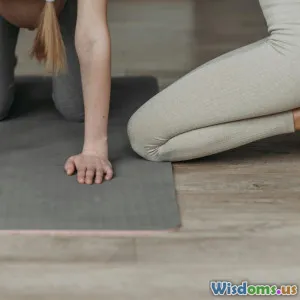
Mistakes Beginners Make When Starting Yoga and How to Avoid Them
6 min read Discover common yoga mistakes beginners make and learn expert tips to practice safely and effectively from the start. (0 Reviews)
Mistakes Beginners Make When Starting Yoga and How to Avoid Them
Embarking on a yoga journey is often filled with excitement and wonder, but, like any new discipline, beginners can face pitfalls that impede progress or even cause injury. Yoga is not only about flexibility or strength but also awareness and mindfulness — concepts sometimes overlooked by new practitioners eager to master poses rapidly. Understanding common mistakes can prevent frustration and ensure a safe, fulfilling experience.
1. Skipping the Foundation: Jumping Too Fast into Advanced Poses
One of the most frequent rookie errors is rushing towards complex asanas such as headstands or deep backbends without mastering foundational poses or building strength gradually. Yoga is a progressive practice, where the body adapts over time.
Example: A beginner attempting a full wheel pose (Urdhva Dhanurasana) without sufficient spinal flexibility or shoulder strength may strain muscles or joints unnecessarily.
Solution: Focus on foundational poses like Downward Dog, Cat-Cow, and Child's Pose, building stability and awareness. Attending beginner classes or using guided videos ensures learning proper form.
2. Ignoring Proper Alignment and Form
Proper alignment ensures muscles and joints move safely and effectively. Beginners often mimic teachers or videos without truly understanding body positioning, risking injury.
Key Alignment Tips:
- Keep knees aligned over ankles in standing poses.
- Engage the core to protect the lower back.
- Avoid locking joints; bones should be supported by muscles.
Dr. Loren Fishman, a clinical professor of rehabilitation medicine, emphasizes that poor alignment can lead to chronic pain rather than relief.
3. Neglecting Breath Awareness
Yoga synchronizes breath with movement (vinyasa). Beginners sometimes focus exclusively on pose completion, overlooking breath control’s vital role.
Why It Matters: Breath supports oxygenation, reduces stress, and aids balance. Shallow or holding the breath can cause dizziness or tension.
Practice Tip: Learn Ujjayi breath—a slow, audible breath through the nose—often used in yoga flow classes.
4. Overstretching and Ignoring Body Limits
Flexibility varies widely, and pushing beyond limits can cause strains, tears, or joint issues.
According to a 2018 study by the International Journal of Sports Physical Therapy, overstretching without control can degrade ligament integrity.
Avoidance Strategy: Listen to your body, stop at the first sign of discomfort, and remember yoga is a lifelong journey toward progress, not perfection.
5. Skipping Warm-Up and Cool-Down Phases
Some beginners jump straight into vigorous sequences without proper warm-ups that prepare muscles and joints. Likewise, cooling down calms the nervous system and promotes recovery.
Warm-Up Suggestions: Gentle stretches and joint rotations can prime the body.
Cool-Down Actions: Restorative poses like Legs-Up-The-Wall or Savasana facilitate relaxation.
6. Comparing Yourself to Others
Yoga studios often feature practitioners of all levels, and comparisons can breed discouragement.
Yoga guru B.K.S. Iyengar famously said, “Yoga does not just change the way we see things, it transforms the person who sees.”
Focus Shift: Concentrate on your individual progress, celebrate small victories, and cultivate the internal benefits rather than external validation.
7. Inconsistent Practice and Unrealistic Expectations
Beginners may expect rapid results in flexibility or stress relief, leading to disappointment or abandonment.
Consistency—not intensity—is key. Even 10-15 minutes daily trumps sporadic long sessions.
Research published by the National Institutes of Health shows patients experienced improved mood and reduced anxiety when practicing gentle yoga regularly over 8 weeks.
Practical Tips to Build a Sustainable Yoga Practice
- Choose the Right Style: Beginners may prefer Hatha or Iyengar yoga, which emphasize alignment and slower pace.
- Seek Qualified Instruction: Certified teachers can provide personalized adjustments that online videos lack.
- Set Realistic Goals: Balance physical improvements with mental well-being objectives.
- Invest in Essential Equipment: A good yoga mat, comfortable clothing, and props like blocks can enhance comfort and safety.
- Practice Mindfulness: Remember yoga extends beyond the mat—encouraging mindful living.
Conclusion
Yoga offers a treasure trove of physical, mental, and emotional benefits accessible to everyone. However, beginners often stumble by rushing progress, ignoring alignment, or overlooking breath and body signals. Avoiding these pitfalls by approaching yoga as a gradual, mindful practice cultivates longevity and joy in your journey.
Remember, as renowned yogi Pattabhi Jois said, “Practice and all is coming.” Embrace patience, listen deeply to your body, and use your practice as a sacred opportunity to grow stronger, healthier, and more centered with every breath.
With awareness and consistency, you’ll avoid common beginner mistakes and unlock the transformative power yoga promises.
Rate the Post
User Reviews
Popular Posts





















